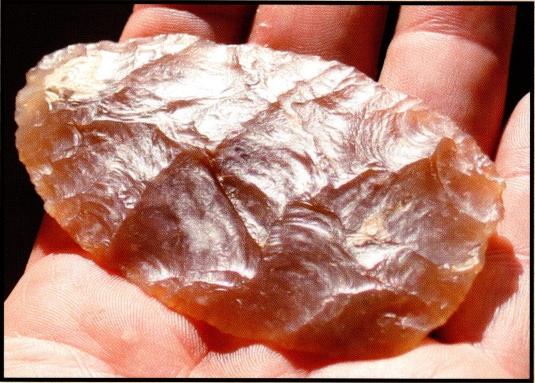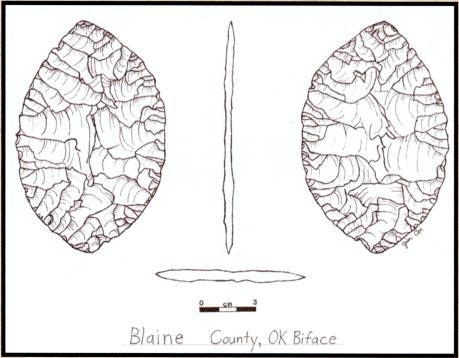By Jim E. Cox, DDS and Tom Westfall

A Folsom ultrathin knife made of Flattop chert. Note how the flakes seem to dive into the middle of the ultrathin knife, generally the thinnest spot on the knife.
The Folsom tradition is best known for its distinctive projectile points. Folsom projectile points are well-knapped and are often made of extremely high-quality lithic material. There is more, however, to the Folsom assemblage than merely projectile points. Scholars in the past decade have also identified some very distinctive, thin flint knives, which have become known as “ultrathin” bifaces.
These tools were made and used by Folsom peoples, and have been recorded in a number of Folsom sites, including Stewart’s Cattle Guard (Colorado), Shifting Sands (West Texas), the Big Black site in North Dakota and others. These very distinctive knives are called “ultrathins” because they are generally between 7 to 13 times as wide as they are thick, although some have been recorded with as much as a 21/1 width to thickness ratio.

These remarkable knives may be over 100 mm long (Shifting Sands) but are generally no thicker than 4 to 6 mm. The most complete ultrathin knife from Shifting Sands measures 3.2 mm at its thinnest spot, and is one of the thinnest ultrathin knives known. A recently found ultrathin from the Arkansas River in Oklahoma is only 2.8 mm thick, making it the thinnest yet recorded. In general, these knives are relatively large and very thin, having ovate, ovate and pointed, or a bipointed outline.
Very few complete specimens have been found as they were apparently used in butchering and were subject to considerable twisting and flex, breaking most. Many show evidence of heavy resharpening before finally being discarded as non-functional. This resulted in a narrowing of the width of these initially broad bifaces.
For example, at the Stewart’s Cattle Guard site, 14 ultrathin fragments representing five distinct bifaces were found. At Shifting Sands, five ultrathin fragments were found along with one complete ultrathin knife. At the Big Black site, 27 ultrathin fragments were recovered in an unmixed Folsom context, and these refit to form 22 ultrathin knives. The Westfall family has found six or seven ultrathin biface fragments, along with two complete ultrathin knives. The majority of these knives measure between 3.8 and 6.5 mm in thickness.

Many ultrathins have large remnant thinning flakes which were removed across the face of the tool. These oppositional thinning flakes often seem to “dive” towards the middle of the knife, and one diagnostic way of determining whether or not a knife is an ultrathin is to determine its thinnest place; most generally, an ultrathin will be thinnest in/near the mid-section of the biface. The lateral margins are often bifacially retouched with marginal pressure flaking to form a straight, sharp edge. Resharpening also resulted in beveled blade edges in some cases.
These tools are quite unique and may ultimately prove to be diagnostic to the Folsom complex. There are, however, very thin bifaces which have been found with a Plainview cache in Texas, and a Cody Complex site in North Dakota. There is some speculation that ultrathin knives may be a bridge tool between Folsom and Cody Complex, although much work remains to be done in support of this hypothesis.
Just above a dated Clovis occupation (11,000-11,500 BP) at the Wilson-Leonard site, and at an 11,000 BP strata at the Gault site (both in Texas) ultrathin knives were found, leading to speculation that this technology was brought forward from late Clovis (transitional) period.
Questions come to mind immediately about why a knapper would go to the bother of making a knife 15 times thinner than wide when they were so readily broken. Ultrathin knives typically show evidence of repeated resharpening; therefore, they were no doubt designed as long-term tools, which were of some importance to their users. According to Dr. Peggy Jodry, principle investigator at the Cattle Guard site and a Folsom expert who has done use-wear analysis on ultrathins, these knives were hand held and designed for light butchering and meat cutting. She speculates that having a specialized tool to help with the labor-intensive task of butchering probably made these tools worth the effort necessary to make them and keep them in good repair.

Folsom ultrathin knife from Oklahoma.
Photo courtesy of Jim Cox.
Imagine that your band of hunters has successfully killed a number of bison. Now remember that the bison of the terminal Pleistocene were large animals (Folsom-age bison cows were about the size of modern day bison bulls!). The tasks ahead—gutting, cutting into pieces, marrow processing, drying, filleting, hide tanning, and then transporting—were daunting. It is highly unlikely that the “after-kill” processing was something that was taken lightly. The animals were dead, but the real work of turning them into food and clothing was just beginning. A highly specialized tool which was thin enough to cut between a massive bison’s ribs for filleting would have been highly valuable!
According to Jodry, “The ultrathin knife may well have been a woman’s knife, akin to the ulu in the north.” Although Jodry believes both male and female members of Folsom society could make their own tools, she suggests that there was a division of labor along age and gender lines. Men hunted (and their knapping skills were evident in the manufacturing of projectile points), and women processed the kill. Repetition of tasks breeds efficiency, and the ultrathin knife may be the result of basic Folsom technology (biface reduction) being applied to a specific task (filleting bison.)

During Folsom times, there was abundant water on the High Plains. This meant that Folsom people had to be highly mobile and follow the animals, rather than staking out a known watering hole and waiting for the animals to come to them. When following animals, the availability of lithic material for retooling would have been unpredictable. This would have required an efficient tool assemblage. There has been much discussion about staged biface reduction technology, which witnessed large bifaces being manufactured at quarry sites, and then transported as part of the tool assemblage. These large implements were functional as “cores” from which large flakes could be removed to be used as tools. Flake removal was generally conducted in a manner that maintained the biface as a functional tool as well as a core. Eventually, these bifaces would be reduced down to the point where they were usable points. This strategy maximized efficiency in terms of transportation of tools in pursuit of bison.

Interestingly, the ultrathin does not appear to be part of the staged biface reduction technology. Rather, evidence suggests that these bifaces were manufactured through a distinct production sequence, suggesting that they were a “goal in and of themselves”. Finished ultrathins are simply too thin to be made into fluted points, although more study will need to be accomplished before a definitive answer is available. There is some speculation that a broken ultrathin would have been ideal for being reworked into a Midland point. Some Midland points, including several of those at Shifting Sands site, exhibit flaking often associated with ultrathin production. Indeed, there is a Midland point from North Dakota made from the center section a Knife River Flint ultrathin biface.

According to Root, et al., ultrathin bifaces may represent a “. . . dual strategy in which early stage reduction was designed to produce flake blanks, and later stage reduction was designed to produce extremely thin and sharp cutting tools”. At the Big Black site, four ultrathin preforms were discovered showing evidence of early stage thinning scars that terminated at or near the opposite edge from which they were removed. This is highly suggestive of large flakes having been removed for blanks.
Although the ultrathin has only recently been recognized as a distinct tool form, it is one of the most wellknapped, functional, and highly sought after knives of the Great Plains. Further research on a number of Folsom sites is presently underway. When coupled with the efforts of both professional and avocational archaeologists working hard to expand the number of recorded ultrathin knives available for study, additional illumination concerning the role of the ultrathin knife in the Folsom tool assemblage should be forthcoming.

Dan Maas’ ultrathin biface found in Wyoming

Shifting Sands site: West Texas. Edwards Plateau chert.
Richard Rose collection.